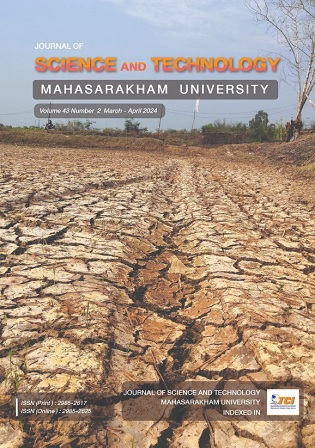Machine Learning for Prediction the Severity of Restrictive Defect of Lung among Factory Workers
Main Article Content
Abstract
Restrictive lung disease such as pneumoconiosis is the most common disease among people working in dusty environment such as mine and industry. The gold standard diagnosis for this disease is spirometry, which is used to evaluate both obstructive defect and restrictive defect. However, this tool has certain limitations such as high service costs, limited access to the device, and availability of specialists. These limitations impede early detection of this disease. The objective of this study is to use machine learning algorithms to help predicting the severity of restrictive defect among factory workers. Three severity classes considered are Normal, Mild, and Moderate or Severe. By using spirometry’s results and behavioral data among workers in a furniture factory in Thailand, six machine learning algorithms were developed, including Logistic Regression, Decision Tree, Random Forest, Gradient Boosting, XGBoost and Support Vector Machine (SVM). The best model is Random Forest with Synthetic Minority Oversampling (SMOTE) to deal with imbalance class and Recursive Feature Elimination (RFE) to select most important features. The important features are weight, height, age, education, hours of work, smoking, mask wearing at the f1-score = 0.746, precision = 0.743, recall = 0.756, and accuracy = 0.75. The model was deployed through a web application for ease of use. The application was used among the factory workers for early screen of the disease. The users were satisfied with the application for its effectiveness, ease of use, time, and cost savings. The tool may increase the chances for early detection and assessment of restrictive lung disease and reduce the burden of future diseases.
Article Details
References
Chandran, U., Reps, J., Yang, R., Vachani, A., Maldonado, F., & Kalsekar, I. (2023). Machine Learning and Real-World Data to Predict Lung Cancer Risk in Routine Care. Cancer epidemiology, biomarkers & prevention : a publication of the American Association for Cancer Research, cosponsored by the American Society of Preventive Oncology, 32(3), 337–343. https://doi.org/10.1158/1055-9965.EPI-22-0873
Gould, M. K., Huang, B. Z., Tammemagi, M. C., Kinar, Y., & Shiff, R. (2021). Machine Learning for Early Lung Cancer Identification Using Routine Clinical and Laboratory Data. American journal of respiratory and critical care medicine, 204(4), 445–453. https://doi.org/10.1164/rccm.202007-2791OC
Guo, Y., Yin, S., Chen, S., & Ge, Y. (2022). Predictors of underutilization of lung cancer screening: a machine learning approach. European journal of cancer prevention : the official journal of the European Cancer Prevention Organisation (ECP), 31(6), 523–529. https://doi.org/10.1097/CEJ.0000000000000742
Hazra, A., Bera, N., & Mandal, A. (2017). Predicting Lung Cancer Survivability using SVM and Logistic Regression Algorithms. International Journal of Computer Applications, 174, 19-24. doi:10.5120/ijca2017915325
HITAP. (2017). รายงานวิจัย: การศึกษาการเข้าถึงบริการตรวจสมรรถภาพปอดด้วยวิธี spirometry ที่มีประสิทธิภาพ ในโรงพยาบาลชุมชน. Retrieved from https://www.hitap.net/documents/173095
Kaplan, A., Cao, H., FitzGerald, J. M., Iannotti, N., Yang, E., Kocks, J. W. H., . . . Mastoridis, P. (2021). Artificial Intelligence/Machine Learning in Respiratory Medicine and Potential Role in Asthma and COPD Diagnosis. The Journal of Allergy and Clinical Immunology: In Practice, 9(6), 2255-2261. doi:10.1016/j.jaip.2021.02.014
Kumar, N., Narayan Das, N., Gupta, D., Gupta, K., & Bindra, J. (2021). Efficient Automated Disease Diagnosis Using Machine Learning Models. Journal of Healthcare Engineering, 2021, 9983652. doi:10.1155/2021/9983652
Kunpeuk, W., Julchoo, S., Phaiyarom, M., Sosom, J., Sinam, P., Sukaew, T., . . . Siriruttanapruk, S. (2021). A Scoping Review on Occupational Exposure of Silica and Asbestos among Industrial Workers in Thailand. Outbreak, Surveillance, Investigation & Response (OSIR) Journal 14(2), 41-51. Retrieved from http://osirjournal.net/index.php/osir/article/view/231
Liu, H., Tang, Z., Yang, Y., Weng, D., Sun, G., Duan, Z., & Chen, J. (2009). Identification and classification of high risk groups for Coal Workers' Pneumoconiosis using an artificial neural network based on occupational histories: a retrospective cohort study. BMC Public Health, 9(1), 366. doi:10.1186/1471-2458-9-366
Luize, A. P., Menezes, A. M., Perez-Padilla, R., Muiño, A., López, M. V., Valdivia, G., Lisboa, C., Montes de Oca, M., Tálamo, C., Celli, B.,
Nascimento, O. A., Gazzotti, M. R., Jardim, J. R., & PLATINO Team (2014). Assessment of five different guideline indication criteria for spirometry, including modified GOLD criteria, in order to detect COPD: data from 5,315 subjects in the PLATINO study. NPJ primary care respiratory medicine, 24, 14075. https://doi.org/10.1038/npjpcrm.2014.75
Martinez-Pitre, P. J., Sabbula, B. R., & Cascella, M. (2022). Restrictive Lung Disease. In StatPearls. Treasure Island (FL): StatPearls Publishing Copyright © 2022, StatPearls Publishing LLC.
Pascoe, S. J., Wu, W., Collison, K. A., Nelsen, L. M., Wurst, K. E., & Lee, L. A. (2018). Use of clinical characteristics to predict spirometric classification of obstructive lung disease. Int J Chron Obstruct Pulmon Dis, 13, 889-902. doi:10.2147/copd.S153426
Qi, X. M., Luo, Y., Song, M. Y., Liu, Y., Shu, T., Liu, Y., Pang, J. L., Wang, J., & Wang, C. (2021). Pneumoconiosis: current status and future prospects. Chinese medical journal, 134(8), 898–907. https://doi.org/10.1097/CM9.0000000000001461
Thetkathuek, A., Yingratanasuk, T., Demers, P. A., Thepaksorn, P., Saowakhontha, S., & Keifer, M. C. (2010). Rubberwood dust and lung function among Thai furniture factory workers. Int J Occup Environ Health, 16(1), 69-74. doi:10.1179/107735210800546281


